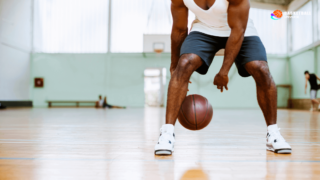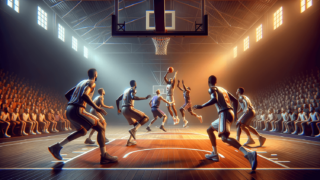
In the dynamic world of basketball, strategies can make or break a game, and one such tactic is the renowned Weakside Help Defense. If you’ve ever been curious about this game-changing defensive maneuver, you’ve come to the right place! In this fun-yet-professional blog post, we’ll dive into the intricacies of the Weakside Help Defense. So, lace up your sneakers, warm up your analytical muscles, and get ready to master the ins and outs of this fundamental technique that can elevate your team’s defensive prowess to new heights!
What’s a Weakside Help Defense in Basketball?
A Weakside Help Defense in basketball is a strategic team defense mechanism, where players on the weak side (away from the ball) shift towards the ball handler to provide support and pressure. This approach aims to deter penetration, compensate for mismatches, disrupt offensive plays, and ultimately increase the likelihood of forcing a turnover or a low-percentage shot.
Unlocking the Secrets of Weakside Help Defense
Ready to delve into the fascinating world of basketball defense? Great! Let’s start by uncovering the underlying principles of the Weakside Help Defense, the roles of each player, and how you can apply this knowledge to boost your team’s performance. It’s time for the ultimate defensive revelation!
The Building Blocks of a Solid Weakside Help Defense
Before implementing the Weakside Help Defense strategy on the court, it’s crucial to understand the fundamental concepts that make it tick. These general guidelines will establish the foundation for an effective Weakside Help Defense, which can then be personalized for your team’s unique gameplay.
The Importance of Court Awareness
A successful Weakside Help Defense demands impeccable court awareness from every player. The aim is to anticipate the offense’s moves, control open spaces, and maintain a strong defensive presence. Players must be prepared to switch roles fluidly and recognize when and where to provide help. In short, each player should possess a heightened sense of situational awareness as they maneuver around the court.
Dividing the Court: Strong Side vs. Weak Side
To better understand the Weakside Help Defense, it’s essential to grasp the distinction between the strong side and the weak side of the court. The strong side refers to the side where the ball is currently being handled, while the weak side is the opposite side of the court. By split-second calculations, players identify their roles in the defense scheme as they transition between the strong side (on-ball defense) and weak side (help defense).
Basic Principles of Weakside Help Defense
The principles of Weakside Help Defense revolve around three primary objectives: providing support, applying pressure, and preventing easy baskets. Players should focus on the following tactics to help achieve these goals:
- Narrow the Gap: Players on the weak side must position themselves in the “help” or “gap” position, reducing the space between them and the ball handler to limit his options.
- Contain Penetration: By closing off potential driving lanes, the Weakside Help Defense deters penetration and encourages offensive players to make long-range or contested shots.
- Identify Mismatches: In cases where mismatches occur (e.g., a player is guarding a much taller, faster, or stronger opponent), the help defender must be prepared to step in and offer assistance, either by doubling up or switching assignments as needed.
Player Roles in Weakside Help Defense
While the specific responsibilities of each player in a Weakside Help Defense may vary depending on the game situation, there are general roles that every player should be familiar with. Understanding these roles will enable players to adapt quickly and help their teammates as the defense shifts and evolves throughout the game.
On-ball Defender
The on-ball defender is responsible for pressuring and containing the ball handler on the strong side of the court. Typically, this player should force the ball handler towards the baseline or the middle of the court, depending on the team’s defensive strategy. It’s crucial for the on-ball defender to maintain a solid stance, stay in front of the player with the ball, and contest any shot attempts aggressively.
Helpside Defender
The helpside defender—usually located on the weak side of the court—must be prepared to provide assistance to the on-ball defender. This player should always have one eye on the ball and another on their assigned offensive player. Quick, decisive rotations are the key to a successful Weakside Help Defense, allowing the helpside defender to step in at the right moment, without losing track of their own man.
Rotating and Recovering Defenders
When the helpside defender commits to assisting the on-ball defender, the remaining players must compensate by rotating to cover any resulting gaps in the defense. Communication is vital, as defenders on the weak side should signal when they’re moving into a help position, so their teammates can adjust accordingly. After thwarting the offense’s attack, recovering to the original assignments or transitioning to a new plan is crucial for maintaining a defensive advantage.
Drills to Reinforce Weakside Help Defense
Developing a tenacious Weakside Help Defense requires dedicated practice and a willingness to work together as a team. Try incorporating these drills into your practice sessions to refine your team’s defensive prowess.
Shell Drill
The Shell Drill is a fundamental basketball exercise that teaches players to maintain proper positioning in relation to the ball and their assigned offensive player. This drill is perfect for honing court awareness, communication, and rotations in a Weakside Help Defense scenario. Coaches can modify the Shell Drill to include additional complexities or stress specific defensive concepts based on their team’s needs.
3-on-3 Help and Recover Drill
The 3-on-3 Help and Recover Drill simulates game scenarios and provides opportunities for players to practice their defensive rotations and recoveries. With two teams of three players, have the offensive team initiate half-court plays, while the defensive team implements the principles of Weakside Help Defense. The defense must rotate quickly to offer help, then recover to their original assignments or new positions as required.
Closeout Drills
Closeout drills train players to close the space between themselves and their assigned player swiftly and under control, whether they’re providing help in a Weakside Help Defense or contesting a shot. Players should focus on maintaining a low, balanced stance as they approach the offensive player and thwarting any attempts to penetrate or shoot effectively.
Implementing a Winning Weakside Help Defense
Now that you’re equipped with an in-depth understanding of the Weakside Help Defense, it’s time to apply this knowledge on the court! Remember, a successful Weakside Help Defense requires commitment, communication, and teamwork. Don’t forget to continually practice and perfect your defense, while adapting and modifying your strategy as needed to address your team’s strengths and weaknesses. Let’s get out there and shut down the opposition!
Weakside Help Defense: Tips and Tricks
On top of the fundamentals we’ve discussed so far, there are some extra tips and tricks that can give your Weakside Help Defense an edge on the court. Enhance your team’s performance by incorporating these key insights into your defense strategy.
Communicate Effectively
Constant communication is a cornerstone of an effective Weakside Help Defense. Players should keep each other informed of their positions, potential dangers, and rotations. This verbal exchange helps maintain cohesion while also disrupting the offense’s communication and rhythm. Make sure you develop clear, concise terms and signals to keep your teammates in sync.
Scouting Offense’s Tendencies
A proactive approach to Weakside Help Defense involves scouting your opponents in advance. Get to know their favorite plays, offensive patterns, and each player’s strengths and weaknesses. Armed with this information, your team can tailor its defense to exploit your rivals’ vulnerabilities and anticipate their moves, making your Weakside Help Defense even more potent.
Mastering Defensive Footwork
Agile and highly efficient footwork is key to a successful Weakside Help Defense. Quick, controlled movements enable defenders to provide timely assistance, rotate effectively, and recover defensive positions. Integrating exercises that focus on foot speed, agility, and balance into your practice sessions will pay off in terms of enhanced defensive performance.
Maintaining Proper Spacing
Appropriate spacing between defenders is vital for a coherent and impenetrable Weakside Help Defense. Ensuring enough distance between players prevents overcommitment, while preserving the ability to rotate and help as needed. Strive to maintain a balanced defensive formation, with the right spacing relative to the ball, teammates, and offensive players.
Analyzing Weakside Help Defense in Action
Watching and studying real-game instances of Weakside Help Defense can provide valuable insights into its practical application. By examining how professional teams handle various situations, you and your teammates can learn new techniques and tactics to further refine your team’s defensive capabilities.
Breaking Down Elite Defenders’ Game Tape
Get your hands on game tape featuring known elite defenders and analyze their skills, footwork, decision-making, and communication. Take note of how they execute Weakside Help Defense, as well as their other defensive techniques. Sifting through and dissecting their strategies could lead to crucial takeaways for your team.
Identifying Areas of Improvement
When analyzing game footage, pay close attention to situations where a Weakside Help Defense breaks down. Identify the key factors that contributed to the lapse, and discuss these points with your teammates. Recognizing and rectifying any weak links in your team’s Weakside Help Defense can help you stay ahead of the competition.
Simulating Game Scenarios
Armed with insights from watching professionals in action, incorporate those lessons into practice sessions and game preparation. Delegate various roles and simulate game scenarios, observing how your teammates react and adjust to different situations. Practice makes perfect, so the more your team internalizes effective Weakside Help Defense strategies, the better their performance will be in real games.
By honing your Weakside Help Defense with these tips and tricks, your team will be well-equipped to face even the most challenging opposition. Keep at it, and enjoy the thrill of spectacular defensive triumphs on the basketball court!
FAQ: Unraveling the Mysteries of Weakside Help Defense
Are you still hungry for more knowledge about Weakside Help Defense? Don’t worry; we’ve got you covered! Here’s a comprehensive FAQ section that answers some of the most common questions related to this defensive strategy, sure to satisfy your curiosity and leave you with a complete understanding.
1. Why is Weakside Help Defense important in basketball?
Weakside Help Defense is essential because it allows the defending team to apply pressure, limit penetration, and prevent easy scoring opportunities for the offense. It also plays a crucial role in compensating for mismatches and disrupting offensive plays, ultimately contributing to a more robust overall defensive strategy.
2. How can I improve my Weakside Help Defense skills?
You can improve your Weakside Help Defense skills by working on court awareness, communication, footwork, and proper positioning. Also, participate in regular team practice sessions and drills such as the Shell Drill, Closeout Drills, and 3-on-3 Help and Recover Drill to master the technique effectively.
3. What is the role of communication in Weakside Help Defense?
Communication is vital in Weakside Help Defense to ensure seamless coordination among players, timely rotations, and swift adaptability to address offensive threats. Effective communication helps maintain a unified and efficient defense, proactively disrupt the offense, and facilitate better team chemistry on the court.
4. How can I predict which side will become the weak side during a game?
The weak side is determined by the location of the ball on the court. When the ball is being handled on one side (the strong side), the opposite side becomes the weak side. Therefore, it can change multiple times throughout the game, and players must continually adjust their positions and tactics accordingly.
5. How can I help my teammates when guarding an offensive player on the weak side?
By positioning yourself in the “gap” or “help” position, you can contribute to the Weakside Help Defense by narrowing the gap between you and the ball handler. This strategic positioning enables you to quickly rotate and provide support to the on-ball defender and limit the offense’s options.
6. When should I leave my assigned player to help on the weak side?
You should leave your assigned player and provide help on the weak side when you see that the on-ball defender is struggling, there’s a mismatch, or when the offense is exploiting a gap in your defense. However, it’s essential to maintain awareness of your original player, rotate quickly, and communicate with teammates.
7. How does scouting my opponents help with Weakside Help Defense?
Scouting your opponents allows you to better understand their offensive tendencies, favorite plays, and each player’s strengths and weaknesses. By using this knowledge, you can tailor your team’s Weakside Help Defense to exploit your rivals’ vulnerabilities and become more reactive and adaptable during the game.
8. What are the responsibilities of the helpside defender in Weakside Help Defense?
The helpside defender must be prepared to offer support to the on-ball defender, maintain court awareness, and react swiftly to any offensive threats. They should have one eye on the ball handler and another on their assigned offensive player. Efficient rotations and quick decisions are crucial for the helpside defender’s success.
9. How is a weak-side defender different from an on-ball defender?
The on-ball defender is responsible for pressuring and containing the ball handler, while the weak-side defender plays a support role by anticipating offensive threats, providing assistance when needed, and maintaining proper positioning for rotations. In essence, the on-ball defender focuses on the strong side, whereas the weak-side defender keeps an eye on the weak side of the court.
10. Can weak-side defenders also double-team the ball handler?
Yes, weak-side defenders can double-team the ball handler if the situation requires it or if the team’s defensive strategy involves applying pressure through double-teaming. However, doing so can create openings in the defense, so players must rotate and recover quickly to avoid leaving their assigned players unguarded.
11. Do all players need to know how to play weak-side help defense?
Yes, all players should be familiar with the weak-side help defense principles and tactics since the positions and roles can change rapidly during a game. Comprehensive understanding and adaptability among all players contribute to a robust and cohesive team defense, prepared to counter any offensive threats.
12. How can I speed up my defensive rotations in Weakside Help Defense?
To speed up your defensive rotations, work on improving your footwork, agility, and court awareness. Anticipate offensive actions, stay primed to switch roles, and maintain constant communication with teammates to ensure smooth and effective movement on the court.
13. How does the Weakside Help Defense strategy fit into a team’s overall defense?
The Weakside Help Defense is an essential component of a team’s overall defense, contributing to a more proactive and flexible defensive strategy. By actively providing support, containing penetration, and stopping easy basket opportunities, the Weakside Help Defense complements other defensive schemes, such as man-to-man, zones, and traps, ensuring a stronger and more resilient defensive approach.
Featured Posts
- No pillar pages found.





